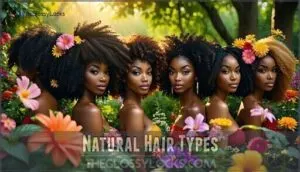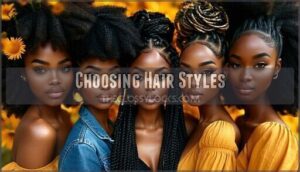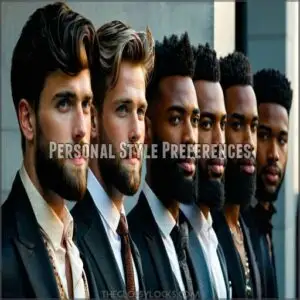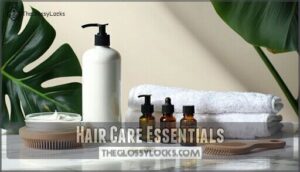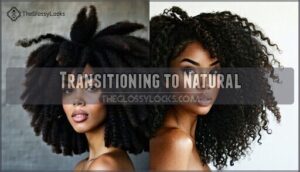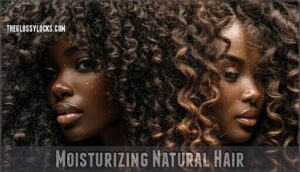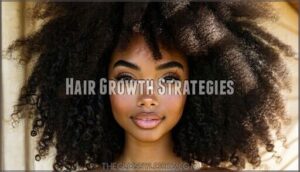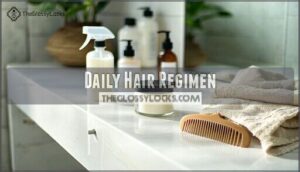This site is supported by our readers. We may earn a commission, at no cost to you, if you purchase through links.
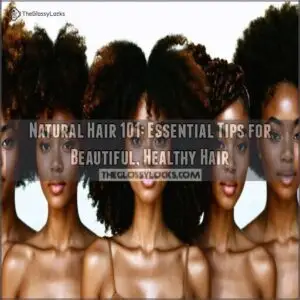 Natural hair 101 is all about understanding your texture and giving it the care it deserves.
Natural hair 101 is all about understanding your texture and giving it the care it deserves.
Whether your hair is curly, coily, kinky, wavy, or straight, the key is moisture, protection, and patience.
Use sulfate-free shampoos to avoid stripping your hair, and deep condition regularly for softness and strength.
Protective styles, like braids or twists, can reduce breakage, while the LOC method (leave-in, oil, cream) keeps moisture locked in.
Trimming split ends and nourishing your hair with a healthy diet are musts for growth.
Natural hair thrives on routine, so find what works and stick with it—you’ll love the results!
Table Of Contents
- Key Takeaways
- Natural Hair Types
- Choosing Hair Styles
- Hair Care Essentials
- Transitioning to Natural
- Moisturizing Natural Hair
- Hair Growth Strategies
- Daily Hair Regimen
- Frequently Asked Questions (FAQs)
- How do you start natural hair for beginners?
- What are the 4 types of natural hair?
- Why is 4C hair so hard to take care of?
- What is a good natural hair routine?
- What are the best techniques for detangling natural hair?
- How can I prevent split ends in natural hair?
- Are there specific tips for reducing scalp buildup?
- What role does water quality play in hair health?
- How do weather changes affect hair porosity?
- Conclusion
Key Takeaways
- Keep your hair moisturized by using the LOC method (leave-in, oil, cream) and deep conditioning regularly to prevent dryness and breakage.
- Use sulfate-free shampoos to gently cleanse without stripping natural oils, ensuring healthier and hydrated hair.
- Protect your hair with styles like braids or twists, and trim split ends every 8-12 weeks to maintain hair growth and reduce damage.
- Understand your hair type and porosity to choose the right products and techniques for moisturizing, detangling, and styling effectively.
Natural Hair Types
Understanding your natural hair type is the first step to creating a care routine that suits your unique texture.
From straight to coily, each type has its own needs, so knowing yours can make all the difference. From straight to coily, each type has its own needs, so knowing yours can make all the difference.
Curly Hair Care
Curly hair thrives on moisture and routine care.
Moisture nourishes curls, while consistent care keeps them thriving—unlock the secret to smooth, defined, and healthy strands!
Use a thick conditioner for hydration and tangle-free strands—detangling with a wide-toothed comb works wonders.
For Curl Definition and Frizz Control, choose lightweight products that enhance shine.
Many people find specific conditioners helpful for curly hair.
Overnight Protection is easy: pineapple your natural curls or sleep with a silk scarf.
Consistent natural hair care creates a smooth, defined curly hair routine!
Coily Hair Maintenance
Coily hair, especially 4C hair, needs extra love to stay healthy.
Shrinkage solutions, detangling methods, and protective styling are your best friends.
Keep product buildup at bay and focus on these basics:
- Use coily hair products like moisturizing creams and sulfate-free cleansers.
- Detangle gently with a wide-tooth comb to prevent breakage.
- Deep condition weekly for hydration.
Many people find success when using specialized hair products.
Kinky Hair Management
Managing kinky hair (4C hair) means working with its unique beauty and challenges.
Shrinkage solutions like moisturizing weekly with coily hair products help retain length.
Moisture retention is key—try deep conditioning and protective styling.
For detangling, use your fingers or a wide-tooth comb on damp hair.
Natural hair 101 tip: prioritize gentle care to define natural curls and avoid breakage, focusing on moisture retention.
Wavy Hair Styling
Styling wavy hair means boosting its natural charm.
Try the diffuser technique to enhance your curl pattern or use scrunching methods for that effortless Beach Waves look.
Product layering—like a curl cream followed by a lightweight gel—helps with defining natural curls.
Spritz water or use a curl refresher midweek for revitalizing waves and reviving those natural hairstyles!
Straight Hair Texture
Straight hair can be sleek but often comes with challenges like an oily scalp or product buildup.
To keep it healthy:
- Use lightweight shampoos to avoid grease.
- Add a volume boost with mousse.
- Incorporate regular clarifying to remove buildup.
- Embrace gentle styling tips for fine strands.
- Balance moisture for your natural hair texture daily to maintain a healthy scalp.
Choosing Hair Styles
When choosing a hairstyle, consider your hair texture, lifestyle, and how much time you want to spend maintaining it.
Picking styles that complement your natural pattern makes care easier and keeps your hair looking its best.
Factors for Style Selection
Selecting natural hair styles starts with your hair length, face shape, and curl pattern.
Think about the event type—an updo might be perfect for formal settings.
Consider hairstyle complexity and how much time you’ll spend maintaining it. For example, if you prefer quick routines, opt for styles with lower maintenance levels that suit your natural hair texture and lifestyle.
Understanding your hair type, such as coily or tightly coiled, can further inform your styling choices.
Hair Texture Considerations
Your natural hair’s texture—whether fine, medium, or coarse—shapes how styles work for you.
Hair porosity and density impact moisture retention and product application, while texture blends and curl patterns add complexity.
Embrace your unique combination by considering hair typing and experimenting with styles that highlight your texture’s beauty. There’s no one-size-fits-all; understand your hair’s story and let it shine!
Personal Style Preferences
Choosing natural hair styles reflects your personal identity and self-expression.
From bold hair accessories to versatile styling options, let your choices boost confidence and celebrate your unique beauty.
Consider cultural influences and embrace what feels authentic to you.
Remember, aligning styles with your face shape enhances natural features, showing the world your individuality with every twist, curl, or braid.
Lifestyle Influences
Your daily routine shapes your natural hair journey. From self-acceptance to inclusivity, your lifestyle impacts hair health and style choices.
- A balanced diet and hair-friendly nutrients keep strands strong.
- Exercise benefits include better blood flow, supporting growth.
- Sleep quality and stress impact moisture retention—prioritize rest.
- Medication effects can alter texture; consult professionals to adapt your routine.
Hair Care Essentials
You can’t achieve healthy natural hair without a strong foundation, and that starts with the right essentials.
From sulfate-free shampoos to deep conditioning and proper moisturizing, each step works together to keep your hair vibrant and resilient.
Sulfate-Free Shampoos
Switching to a sulfate-free shampoo transforms natural hair care.
Switching to sulfate-free shampoo is a game-changer—gentle cleansing that preserves moisture and keeps your curls hydrated and happy!
These hair products gently cleanse without stripping oils, reducing scalp sensitivity and frizz.
Sulfate alternatives like coconut milk strengthen strands while moisturizing.
Though ingredient analysis shows sulfate-free shampoos may struggle with product buildup, they’re perfect for preserving curls’ hydration.
Many consumers find quality options available online.
Embrace sulfate-free options for shampoo benefits and healthier hair every wash!
Deep Conditioning Benefits
With deep conditioning, your hair gets the TLC it deserves.
It’s like a hydration spa day for your strands, boosting elasticity and repairing damage.
Frizz reduction? Check. Shine enhancement? Absolutely.
This helps with hair moisture and conditioning, improving porosity for better hydration.
Treat yourself weekly—your hair will thank you with bounce, strength, and manageable softness!
Moisturizing Techniques
Moisturizing natural hair is key to hair hydration.
Try the LOC Method—apply a liquid (like water), a humectant or cream, then seal with oil for lasting moisture.
Nighttime moisture matters too; a light cream application before bed helps lock in hydration.
Regularly sealing prevents dryness, while deep conditioning boosts hair moisture, leaving curls soft and manageable.
Protein-Moisture Balance
Finding the right protein-moisture balance is key for healthy, bouncy natural hair.
Overdoing protein causes stiffness, while moisture deficiency leads to dull, lifeless locks.
A balanced regimen suited to your hair porosity promotes elasticity and strength.
- Use products with proper ingredient ratios for natural hair care.
- Alternate between hair protein treatments and moisturizing natural hair.
- Test your hair’s elasticity to check progress.
Transitioning to Natural
Making the switch to natural hair takes patience and consistency, but it’s worth it when you see your curls thrive.
With the right plan and products, you can embrace your natural texture while keeping your hair healthy and manageable.
Weather and Hair Care
When seasons shift, your natural hair’s needs change too.
Humidity effects in summer can spike hair frizz, while winter dryness calls for extra moisturizing.
Protect your strands from sun damage with hats or SPF-based sprays.
Adjust your product selection to fit your hair porosity and guarantee it stays hydrated. Seasonal adjustments keep hair dryness at bay beautifully!
Increased Care Requirements
Handling natural hair demands attention to moisture retention and breakage prevention.
Use natural hair products suited to your needs, especially those free of sulfates, to avoid product buildup.
Prioritize scalp health by cleansing regularly and focusing on gentle detangling to minimize hair damage.
Hair porosity impacts care, so understanding yours helps with choosing the right products for effective hair care.
Planning for Transition
Shifting from relaxed to natural hair takes thoughtful planning.
Embrace patience—hair grows, but not overnight.
Regular trims help manage the line of demarcation, while protective styling minimizes breakage.
Choose products to suit your hair texture evolution, and consult experts for personalized advice.
The big chop isn’t for everyone, so let your comfort guide the journey.
Styling Options for Transition
Protective styles like braids or twists are lifesavers when moving to natural hair.
They offer low manipulation, reducing stress on fragile strands.
Blending textures with rod sets or braiding helps smooth the hair texture conversion.
Opt for heatless styling to avoid damage, and don’t shy away from accessorizing hair with scarves or headbands to add flair while protecting hair that’s in a state of change.
Moisturizing Natural Hair
Keeping your natural hair moisturized isn’t just about slathering on products; it’s about locking in hydration and knowing what your hair needs.
With the right routine, you can keep dryness at bay and help your hair thrive.
Frequency of Moisturizing
Moisturizing natural hair depends on its porosity and texture. Low porosity hair needs less frequent hydration, while high porosity craves daily moisture to combat product build-up and dryness.
Climate and over-moisturizing risks also play a role. Assessing hair porosity before moisturizing is essential to determine the right approach.
- Assess hair porosity before moisturizing.
- Avoid overusing products.
- Adjust for humid or dry climates.
Fine hair needs lightweight moisture, while thick textures require richer solutions. This distinction is crucial for effective hair care and to prevent common issues such as dryness or product build-up.
Deep Conditioning Routine
Think of deep conditioning as a spa day for your hair. A good hair mask or DIY recipe, like avocado and honey, revives dry strands.
Use heat for deeper hair moisturizing or go no-heat for gentle care. For best results, consider understanding hair porosity to select the most effective products.
| Step | Ingredient Benefits | Application Methods | Routine Frequency |
|---|---|---|---|
| Choose a product | Hydration, softness | Apply on wet hair | Weekly or bi-weekly |
| Section hair | Even product distribution | Divide into four sections | Each session |
| Cover with cap | Retains moisture | Plastic/shower cap | During treatment |
| Rinse thoroughly | Removes residue | Use cool water | After every treatment |
To achieve the best results from your deep conditioning treatment, remember to rinse thoroughly and consider the frequency of your routine, whether it’s weekly or bi-weekly, to keep your hair healthy and strong. Always prioritize gentle care and the right product selection based on your hair’s specific needs.
LOC Method Explanation
After deep conditioning, keep your natural hair moisturized with the LOC method.
Start with a water-based leave-in for hydration, then layer hair oil to lock it in.
Finally, apply cream to seal moisture and define curls.
This product layering guarantees stronger, healthier hair, especially for wavy, curly, and coily types.
Choose oils and creams suited for your hair’s needs!
Sealing Moisture for Hair
Sealing moisture helps lock hydration into your hair strands, especially for low porosity hair.
Use lightweight oils like jojoba or argan for fine hair, and butters—think shea or mango—for thicker textures.
Pair humectants with oils using proper product layering.
High porosity hair benefits from frequent sealing to combat dryness.
Choose the right hair oil and adjust sealing frequency for lasting moisture.
Hair Growth Strategies
Growing healthy, beautiful hair takes patience, proper care, and a little strategy.
From eating nutrient-rich foods to using protective styles, you’ll find that small changes can make a big difference in achieving your hair goals.
Healthy Eating for Hair
Your plate can impact your hair! Boost hair growth and scalp health with these healthy hair tips:
- Prioritize protein intake—eggs, fish, or beans are great options.
- Include hair vitamins like biotin and vitamin C from nuts and citrus.
- Stay hydrated; water helps prevent dryness.
- Avoid nutrient deficiencies by eating leafy greens for iron and omega-3s for shine.
Consider adding sweet potatoes, which provide beta-carotene for scalp health.
Regular Trimming Benefits
Regular trimming might feel counterintuitive when growing your hair, but it’s essential.
Snipping your hair ends prevents split-ends from traveling up the shaft, reducing breakage, and promotes hair-growth by maintaining hair health, keeping strands strong and vibrant.
Trimming also helps preserve your hair-shape and enhances volume, giving you a fuller look.
Healthy hair length starts with regular trims, which is crucial for maintaining healthy hair.
Protective Styling Techniques
Protective styles like braids, wigs, and weaves shield natural hair from damage while promoting style longevity.
To avoid stress on your scalp, practice proper wig application and braid maintenance.
Moisturize regularly to keep hairstyles fresh, and use gentle takedown methods to prevent breakage.
Protective styling is a go-to solution for healthy, fuss-free hair care and growth.
Length Retention Methods
Keeping your hair long and healthy isn’t magic—it just takes care.
To maintain natural hair growth and length retention:
- Use protective hairstyles to reduce stress on strands.
- Trim regularly to prevent split ends from traveling.
- Moisturize often to minimize breakage and dryness.
- Focus on scalp health, because a healthy scalp means stronger roots.
Your night routine? Essential for protecting hair!
Daily Hair Regimen
Your daily hair regimen is the foundation for keeping your natural hair healthy and strong.
With a consistent routine, you’ll minimize damage, maintain moisture, and enjoy well-managed, beautiful hair every day.
Morning Hair Care Routine
Start your morning hair care routine by gently detangling with your fingers or a wide-tooth comb to avoid breakage.
Massage your scalp for stimulation and use a moisture spray to refresh curls.
Preserve yesterday’s style by re-twisting or smoothing edges with a scarf.
Quick styling tricks like a puff or braid can save time while maintaining your natural hair’s beauty.
Weekly and Monthly Maintenance
In your weekly and monthly natural hair regimen, consistency is key to maintaining healthy locks.
Focus on these essentials:
- Scalp Exfoliation: Remove product buildup for a clean, healthy foundation.
- Deep Conditioning and Protein Treatments: Alternate for moisture balance and stronger hair.
- Trim Schedule: Every 8-12 weeks, trim to prevent split ends and promote growth.
Your hair care routine thrives on balance!
Seasonal Hair Care Adjustments
Adjust your hair routine with the seasons.
Winter hydration combats dryness indoors and out, while summer protection shields against heat and UV rays.
Spring growth? Focus on moisturizing and gentle handling.
Fall shedding is natural—use deep conditioning and nourishing hair products to strengthen strands.
And don’t forget humidity control year-round for frizz-free styles no matter the weather.
For summer months, consider using hair products with UV protection.
Nighttime Hair Care Tips
Your evening hair routine matters as much as your morning one.
Wrap your strands in satin bonnets or silk scarves to protect them from frizz. The Pineappling Method keeps curls intact overnight, while a hydration spritz adds moisture.
Braids? Maintain braid maintenance by securing ends gently. These natural hair tips guarantee your hair care stays effective, and you wake up fabulous with effective hair care.
Frequently Asked Questions (FAQs)
How do you start natural hair for beginners?
Embrace your roots like meeting an old friend—wash gently with sulfate-free shampoo, moisturize often, and deep condition biweekly.
Stick to low-heat styling, trim regularly, and protect your hair with simple, stress-free styles.
What are the 4 types of natural hair?
Natural hair falls into four types: Type 1 (straight), Type 2 (wavy), Type 3 (curly), and Type 4 (coily/kinky). Each type has unique textures, patterns, and care needs—embrace what makes yours beautiful!
Why is 4C hair so hard to take care of?
Caring for 4C hair is like tending a delicate garden; it’s naturally dry, prone to shrinkage, and fragile.
It needs constant moisture, gentle handling, and specific products to lock in hydration and prevent breakage.
What is a good natural hair routine?
Start with gentle cleansing weekly, then follow up with a deep conditioner.
Keep hair moisturized daily with leave-in products.
Use protective styles to reduce breakage, trim regularly, and minimize heat for healthier, stronger natural hair.
What are the best techniques for detangling natural hair?
Detangling natural hair isn’t rocket science, but it does require patience.
Start on damp, sectioned hair, use a wide-tooth comb or fingers, add conditioner for slip.
Always detangle from ends to roots gently.
How can I prevent split ends in natural hair?
Trim your ends every 8-12 weeks, moisturize consistently, and avoid overusing heat.
Prevent breakage by detangling gently with a wide-tooth comb on damp hair, and always seal in moisture with oils or butters.
Are there specific tips for reducing scalp buildup?
Tackle scalp buildup by washing with sulfate-free shampoos weekly, clarifying every 6-8 weeks, and massaging your scalp gently.
Use lightweight oils sparingly and rinse thoroughly to avoid residue.
Your scalp will thank you!
What role does water quality play in hair health?
Water quality impacts your hair’s health more than you’d think.
Hard water, full of minerals, can leave buildup, dry strands, and dullness.
Soft water’s gentler, helping products work better and keeping hair moisturized.
How do weather changes affect hair porosity?
Weather changes can impact your hair’s porosity since humidity opens cuticles, making high-porosity hair frizzier.
While cold, dry air tightens cuticles, leaving low-porosity hair drier.
Seasonal shifts mean adjusting your moisture and care routines.
Conclusion
Did you know the average strand of natural hair grows about half an inch per month?
By understanding your texture and following consistent care routines, you can maximize growth and health.
Embrace the principles of Natural Hair 101: prioritize moisture, protect your strands, and stay patient with the journey.
Stick to sulfate-free shampoos, try the LOC method, and maintain regular trims for best results.
Your natural hair thrives on care and commitment—start today, and you’ll see the difference!
- https://www.byrdie.com/what-is-natural-hair-definition-and-in-depth-look-400268
- https://www.medicinenet.com/what_are_the_four_types_of_hair/article.htm
- https://naturallclub.com/blogs/the-naturall-club-blog/how-to-keep-natural-hair-moisturized-7-tips-from-naturall-club
- https://store.mintel.com/us-black-haircare-market-report?_ga=2.210391509.1979083163.1574860839-748175212.1574860839

